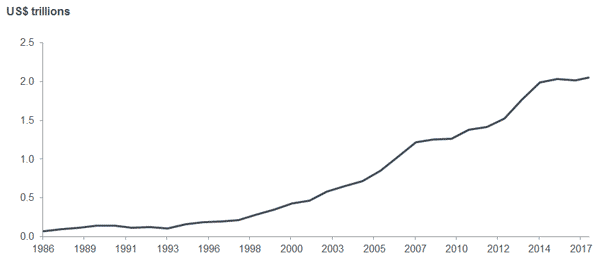A most unusual cycle — the shrinking of the high yield market

6 minute read
There are many aspects of this credit and business cycle, which continue to surprise investors and differ from the textbook expectations of an aging bull market. Jenna Barnard explores one aspect unique to the high yield market, which can explain the relentless demand for bonds.
Along with many asset classes, so-called ‘junk’ bonds are experiencing a year of unparalleled tranquillity. Indeed, the Bank of America US High Yield Index is trading in the tightest spread range of the past 20 years with a high to low range in spreads of only 71 basis points (bp) year to date, while the range has been 118bp for European high yield. This compares to an average of 481bp for the US index over the last 10 years, since the start of the Global Financial Crisis.
While the reasons for the low volatility environment across asset classes are well rehearsed, we wanted to explore one aspect, which is unique to the high yield market and can help explain a relentless demand for bonds. Quite simply, the US high yield market is beginning to shrink. In doing so it is following in the footsteps of the European high yield market where the par value (notional amount) of bonds outstanding peaked in 2014 and has been notably lower ever since (chart 1).
Chart 1: shrinking high yield markets
 Source: BofA Merrill Lynch Global Research, BofA Merrill Lynch Bond Indices, Janus Henderson Investors, as at 30 October 2017.
Source: BofA Merrill Lynch Global Research, BofA Merrill Lynch Bond Indices, Janus Henderson Investors, as at 30 October 2017.
Driving forces
Explaining the shrinkage in the market is relatively simple; it is due to a number of forces, which are explored below. Before doing so however, it is worth taking a step back to reflect on the fact that eight years into a bull market, with close to record low yield levels, corporates appear to lack the exuberant animal spirits that in the past would have encouraged a leveraging up of balance sheets.
It would appear that the scars of the previous crisis continue to run deep. We have spoken in previous articles and videos about the experience of Japan and the lasting impact of a ‘balance sheet recession’ on both corporate and household attitudes to debt. It is also the case that a low growth and low inflation backdrop makes it hard for companies to envisage ‘growing into’ a highly indebted capital structure. Europe led the way in this regard but it is fascinating to see similar footprints in the US.
Changing corporate behaviour
Facing an economic environment with stagnant growth, European corporates have remained relatively conservative in their behaviour. We have commented in the past on the low levels of European merger and acquisition (M&A) activity in this business cycle relative to previous cycles, and the US.
This is particularly noteworthy given how cheaply European corporates can borrow in public bond markets. The European investment grade market currently yields 0.75% and the European high yield market yields 2.12%. The lure of cheap debt seems to exert little force on the European corporate psyche. This has not been the case in the US where investment grade companies have taken full advantage of lower bond yields in this cycle in order to return cash to equity investors.
The US high yield market, however, currently seems to have more in common with Europe, driven by a cautious attitude among private equity sponsors. This is very different to the gung ho attitude exhibited during the 2005-07 private equity boom.
Resurgence of rising stars
While the number of credit rating downgrades has exceeded the number of upgrades in the high yield universe, the volume of debt being upgraded to investment grade has far outweighed that being downgraded to the high yield index.
Typically, it is companies with the bigger capital structures (which make up a larger part of high yield indices) that are engaged in improving their credit profile. Not only does this give them access to cheaper and more plentiful funding (should they need it) in the investment grade market, if and when this cycle eventually turns, they will also be in a relatively better position to weather the storm.
The result is – across both US and Europe – a smaller high yield market, as more bonds are upgraded to investment grade.
The upgrade of Anglo American alone earlier this year, resulted in the loss of $9.6bn (par value) of bonds in the US high yield index. Tesco, which makes up 5.7% of the smaller sterling high yield index, has announced it is focusing on a return to investment grade and is buying back debt with that view in mind. In the case of the European high yield market, Barclays estimates €20bn of debt (par value) will migrate from high yield to investment grade in 2018 with only approximately €5bn going in the opposite direction.
A newfound affinity with loans
In addition to corporates’ changing business strategies, the high yield bond market has faced cannibalisation from its sister asset class – leveraged loans.
Indeed, possibly the biggest trend in the past two to three years for the high yield market has been the resurgence of loan issuance driven by the continued strong demand for collateralised loan obligations (CLOs) and a sense of protection offered by floating rate notes in a ‘rising rate environment’ (or not, as the case may be).
Borrowers have tended to prefer leveraged loan structures, which typically come with far fewer covenants, allowing more operational flexibility for the issuing firm; over 75% of loans outstanding are classified as ‘cov-lite’. In addition to this, the issuers retain the ability to repay or refinance the terms of these loans at very short notice. A large part of loan activity, particularly this year, has been companies refinancing outstanding loans at lower margins.
There is a lot of overlap in the companies that issue high yield bonds and issue debt (loans), and it is no coincidence that the rapid increase in leveraged loans has coincided with a period of decline for high yield debt. Since the end of 2014, the US high yield market has shrunk by 3.7% while the loan market has grown by 12.7%.
In aggregate, the combined size of the US loan and high yield bond markets has been broadly stable since 2014 (chart 2). Again, this is very different to the wave of mega leveraged buyouts (LBOs), which expanded the high yield and loan markets in the 2005-07 period.
Chart 2: combined size of US high yield and loan markets
 Source: BofA Merrill Lynch, Janus Henderson Investors, as at 30 September 2017
Source: BofA Merrill Lynch, Janus Henderson Investors, as at 30 September 2017
Where do we go from here?
There are many aspects of this credit and business cycle, which continue to surprise investors and differ from the textbook expectations of an aging bull market. Our guidepost for much of the divergence in behaviour between European and US corporations continues to be the experience of Japan in recent decades; erasing the memory of a debt trauma takes more than low interest rates.
In contrast, areas where we have observed a willingness to binge on debt in this business cycle are: emerging market corporates, US investment grade companies and the household sector in Australia and Canada. Each such debt boom presents different investment opportunities and risks to an unconstrained bond fund.
Divergence remains the dominant theme for bond investors.
Note: Yields and spreads quoted are correct at the time of writing in late October. Yields may vary and are not guaranteed.
These are the views of the author at the time of publication and may differ from the views of other individuals/teams at Janus Henderson Investors. References made to individual securities do not constitute a recommendation to buy, sell or hold any security, investment strategy or market sector, and should not be assumed to be profitable. Janus Henderson Investors, its affiliated advisor, or its employees, may have a position in the securities mentioned.
Past performance does not predict future returns. The value of an investment and the income from it can fall as well as rise and you may not get back the amount originally invested.
The information in this article does not qualify as an investment recommendation.
Marketing Communication.
Important information
Please read the following important information regarding funds related to this article.
- An issuer of a bond (or money market instrument) may become unable or unwilling to pay interest or repay capital to the Fund. If this happens or the market perceives this may happen, the value of the bond will fall.
- When interest rates rise (or fall), the prices of different securities will be affected differently. In particular, bond values generally fall when interest rates rise (or are expected to rise). This risk is typically greater the longer the maturity of a bond investment.
- The Fund invests in high yield (non-investment grade) bonds and while these generally offer higher rates of interest than investment grade bonds, they are more speculative and more sensitive to adverse changes in market conditions.
- Some bonds (callable bonds) allow their issuers the right to repay capital early or to extend the maturity. Issuers may exercise these rights when favourable to them and as a result the value of the Fund may be impacted.
- If a Fund has a high exposure to a particular country or geographical region it carries a higher level of risk than a Fund which is more broadly diversified.
- The Fund may use derivatives to help achieve its investment objective. This can result in leverage (higher levels of debt), which can magnify an investment outcome. Gains or losses to the Fund may therefore be greater than the cost of the derivative. Derivatives also introduce other risks, in particular, that a derivative counterparty may not meet its contractual obligations.
- When the Fund, or a share/unit class, seeks to mitigate exchange rate movements of a currency relative to the base currency (hedge), the hedging strategy itself may positively or negatively impact the value of the Fund due to differences in short-term interest rates between the currencies.
- Securities within the Fund could become hard to value or to sell at a desired time and price, especially in extreme market conditions when asset prices may be falling, increasing the risk of investment losses.
- Some or all of the ongoing charges may be taken from capital, which may erode capital or reduce potential for capital growth.
- CoCos can fall sharply in value if the financial strength of an issuer weakens and a predetermined trigger event causes the bonds to be converted into shares/units of the issuer or to be partly or wholly written off.
- The Fund could lose money if a counterparty with which the Fund trades becomes unwilling or unable to meet its obligations, or as a result of failure or delay in operational processes or the failure of a third party provider.
